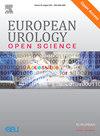Prospective Analysis of Confocal Laser Endomicroscopy for Assessment of the Resection Bed for Bladder Tumor
IF 3.2
3区 医学
Q1 UROLOGY & NEPHROLOGY
引用次数: 0
Abstract
Background and objective
Urothelial bladder cancer (UCB) care requires frequent follow-up cystoscopy and surgery. Confocal laser endomicroscopy (CLE), a probe-based optical technique for real-time microscopic evaluation, has shown promising accuracy for grading of UCB. We investigated the diagnostic accuracy of CLE-based assessment of the surgical radicality of the bladder resection bed (RB).
Methods
We prospectively included 40 participants scheduled for transurethral resection of bladder tumors (TURBT) in two academic hospitals. Exclusion criteria were flat lesions, fluorescein allergy, and pregnancy. We performed CLE of the RB during TURBT. Histopathology of an RB biopsy was the reference test. Results at first cystoscopy 3 mo after TURBT are reported. A panel of two blinded observers evaluated the CLE images. The diagnostic accuracy of CLE for detection of detrusor muscle (DM) and residual tumor (rT) was calculated using 2 × 2 tables.
Key findings and limitations
Histopathology for 22 CLE-matched RB biopsies revealed rT in four cases (18%) and DM in 13 (59%). The quality of CLE imaging was low in four (18%), moderate in 16 (73%), and good in two (9%) cases. CLE was able to correctly predict rT in two of the four cases (50%) identified on histopathology. The sensitivity, specificity, positive predictive value, and negative predictive value were 0.5 (95% confidence interval [CI] 0.07–0.93), 0.83 (95% CI 0.59–0.96), 0.4 (95% CI 0.05–0.85), and 0.88 (95% CI 0.64–0.99) for CLE prediction of rT, and 0.69 (95% CI 0.39–0.91), 0.33 (95% CI 0.07–0.7), 0.6 (95% CI 0.32–0.84), and 0.43 (95% CI 0.1–0.82) for prediction of DM, respectively. Five patients (23%) had rT at 3-mo follow-up; CLE had predicted rT in three, and histopathology had revealed rT in two cases at TURBT.
Conclusions and clinical implications
CLE does not appear to be a reliable tool for detecting rT or DM in the RB after TURBT.
Patient summary
We investigated a special imaging technique called confocal laser endomicroscopy (CLE) for checking the bladder after surgery for bladder cancer in a group of 40 patients. CLE results were compared to traditional biopsy results and the patients were checked after 3 months. CLE was not very reliable in detecting any remaining cancer (only 50% accurate) or important muscle tissue in the surgical area, and the quality of the images varied. While CLE shows some promise, it is not currently a dependable method for evaluating the bladder after bladder cancer surgery.
共聚焦激光内镜对膀胱肿瘤切除床评价的前瞻性分析。
背景与目的:尿路上皮性膀胱癌(UCB)的治疗需要频繁的随访膀胱镜检查和手术。共聚焦激光内镜(CLE)是一种基于探针的实时显微评估光学技术,在UCB分级中显示出良好的准确性。我们研究了基于cle评估膀胱切除床(RB)手术根治性的诊断准确性。方法:我们前瞻性地纳入40名在两所学术医院行膀胱肿瘤经尿道切除术(turt)的患者。排除标准为扁平病变、荧光素过敏和妊娠。我们在TURBT期间对RB进行CLE。RB活检的组织病理学为参考试验。报告TURBT术后3个月首次膀胱镜检查结果。由两名盲眼观察者组成的小组评估CLE图像。采用2 × 2表计算CLE检测逼尿肌(DM)和残余肿瘤(rT)的诊断准确率。主要发现和局限性:22例cle匹配的RB活检组织病理学显示4例(18%)为rT, 13例(59%)为DM。CLE成像质量低4例(18%),中等16例(73%),良好2例(9%)。在组织病理学鉴定的4例病例中,有2例(50%)CLE能够正确预测rT。CLE预测rT的敏感性、特异性、阳性预测值和阴性预测值分别为0.5(95%可信区间[CI] 0.07-0.93)、0.83 (95% CI 0.59-0.96)、0.4 (95% CI 0.05-0.85)和0.88 (95% CI 0.64-0.99),预测DM的敏感性、特异性、阳性预测值和阴性预测值分别为0.69 (95% CI 0.39-0.91)、0.33 (95% CI 0.07-0.7)、0.6 (95% CI 0.32-0.84)和0.43 (95% CI 0.1-0.82)。5例患者(23%)在3个月随访时接受了rT治疗;CLE预测3例rT,组织病理学在TURBT上显示2例rT。结论和临床意义:CLE似乎不是检测TURBT后RB中rT或DM的可靠工具。患者总结:我们研究了一种特殊的成像技术,称为共聚焦激光显微内镜(CLE),用于检查40例膀胱癌手术后的膀胱。将CLE结果与传统活检结果进行比较,并在3个月后对患者进行检查。CLE在检测任何残留的癌症(只有50%的准确率)或手术区域的重要肌肉组织方面不是很可靠,并且图像质量参差不齐。虽然CLE显示出一些希望,但目前还不是评估膀胱癌手术后膀胱的可靠方法。
本文章由计算机程序翻译,如有差异,请以英文原文为准。
求助全文
约1分钟内获得全文
求助全文
来源期刊

European Urology Open Science
UROLOGY & NEPHROLOGY-
CiteScore
3.40
自引率
4.00%
发文量
1183
审稿时长
49 days
 求助内容:
求助内容: 应助结果提醒方式:
应助结果提醒方式:


